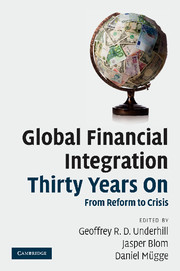Book contents
- Frontmatter
- Contents
- List of figures
- List of tables
- Notes on contributors
- Preface
- Acknowledgements
- List of abbreviations
- Introduction: the challenges and prospects of global financial integration
- Part I History and context: input, output and the current architecture (whence it came)
- Part II Assessing the current financial architecture (how well does it work?)
- Part III Does the future hold? Reactions to the current regime and prospects for progress (where is it going?)
- Conclusion: whither global financial governance after the crisis?
- References
- Index
Conclusion: whither global financial governance after the crisis?
Published online by Cambridge University Press: 02 December 2010
- Frontmatter
- Contents
- List of figures
- List of tables
- Notes on contributors
- Preface
- Acknowledgements
- List of abbreviations
- Introduction: the challenges and prospects of global financial integration
- Part I History and context: input, output and the current architecture (whence it came)
- Part II Assessing the current financial architecture (how well does it work?)
- Part III Does the future hold? Reactions to the current regime and prospects for progress (where is it going?)
- Conclusion: whither global financial governance after the crisis?
- References
- Index
Summary
For global finance, the year 2008 may prove to be a watershed. The collapse of Lehman Brothers on 15 September of that year brought the global financial system to the brink of meltdown, and much of the world has been experiencing the deepest recession for more than half a century. Only the timely intervention of public authorities prevented a rerun of the 1930s depression. A consensus formed around the unsurprising conclusion that global financial governance was in need of reform – both to ensure a more effective and coordinated crisis response and to prevent a rerun in the future. At least ex ante, the London G20 Summit in April 2009 and the Philadelphia follow-up held in the autumn of 2009 were hailed as stepping stones to an overhaul of the global financial architecture. Many observers saw an opportunity for wholesale reform, which had been so conspicuously absent after the crises of the late 1990s and early 2000s, as Helleiner and Pagliari have argued in Chapter 2.
The speed and drama of the crisis have meant that the contributions to this volume ran the risk of obsolescence before they could be published. The crisis might well have ushered in sufficiently dramatic change as to relegate many of the institutions, norms and practices analysed in this book to the dustbin of history.
- Type
- Chapter
- Information
- Global Financial Integration Thirty Years OnFrom Reform to Crisis, pp. 304 - 315Publisher: Cambridge University PressPrint publication year: 2010
- 1
- Cited by

